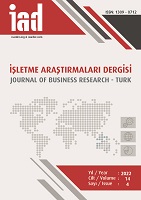CAMELS Göstergeleri Bağlamında Katılım Bankacılığı ve Ekonomik Büyüme İlişkisi: Türkiye Üzerine Bir Uygulama
The Relationship between Participation Banking and Economic Growth in the Context of CAMELS Indicators: A case study in Turkey
Author(s): Caner Dilber, Mercan HatipoğluSubject(s): National Economy, Financial Markets, Socio-Economic Research
Published by: Orhan Sağçolak
Keywords: Participation Banking; Economic Growth: CAMELS Approach; ARDL Model;
Summary/Abstract: Purpose – The aim of this paper is to investigate the relationship between the CAMELS indicators of participation banks and economic growth in Turkey Design/methodology/approach – Two different ARDL models were established as a method in the study. The CAMELS indicator ratios of all participation banks operating in Turkey and real GDP have been analyzed to cover the period 2013Q4-2021Q3.Findings –It was founded that there is a co-integration relationship between the variables for both models. When the long run coefficients are estimated, it has been determined that there is a negative statistically significant relationship between A (asset quality) and economic growth, and a positive statistically significant relationship with the M (management efficiency) variable. When the short run coefficients are examined, there is a statistically significant and negative relationship between CC (capital adequacy) and economic growth, while the results of the A (asset quality)variable is parallel to the long run. A statistically significant and negative relationship was found between the L (liquidity) variable and the previous period value and economic growth. A statistically significant and positive relationship was found between the values of the E1 (earnings) variable one and two periods ago and economic growth. In the short run, the relationship between the values of the E2 (earnings) variable two and three periods ago and economic growth is negative. However, the relationship between the values of the S (sensitivity to market risks) variable one, two, three and four periods ago is positive. In addition, a negative significant relationship was found between the values of the M (management efficiency) variable one, two and three periods ago and economic growth in the short run. Discussion – The results show that if the non-performing financing of participation banking is proportionally higher than the total financing, it has negative effects on economic growth in the long and short term. While the relationship between the capital adequacy and liquidity values of participation banks and economic growth is negative in the short term, this effect disappears in the long term. When the earnings values of the participation banks are evaluated from the previous periods to the actual period, it is concluded that the increase in earnings items affects the economic growth negatively in the short run. While participation banks show a development from negative to positive in terms of management efficiency, they are more affected by market risks such as interest, exchange rate and inflation compared to previous periods.
Journal: İşletme Araştırmaları Dergisi
- Issue Year: 14/2022
- Issue No: 4
- Page Range: 2972-2993
- Page Count: 23
- Language: Turkish

